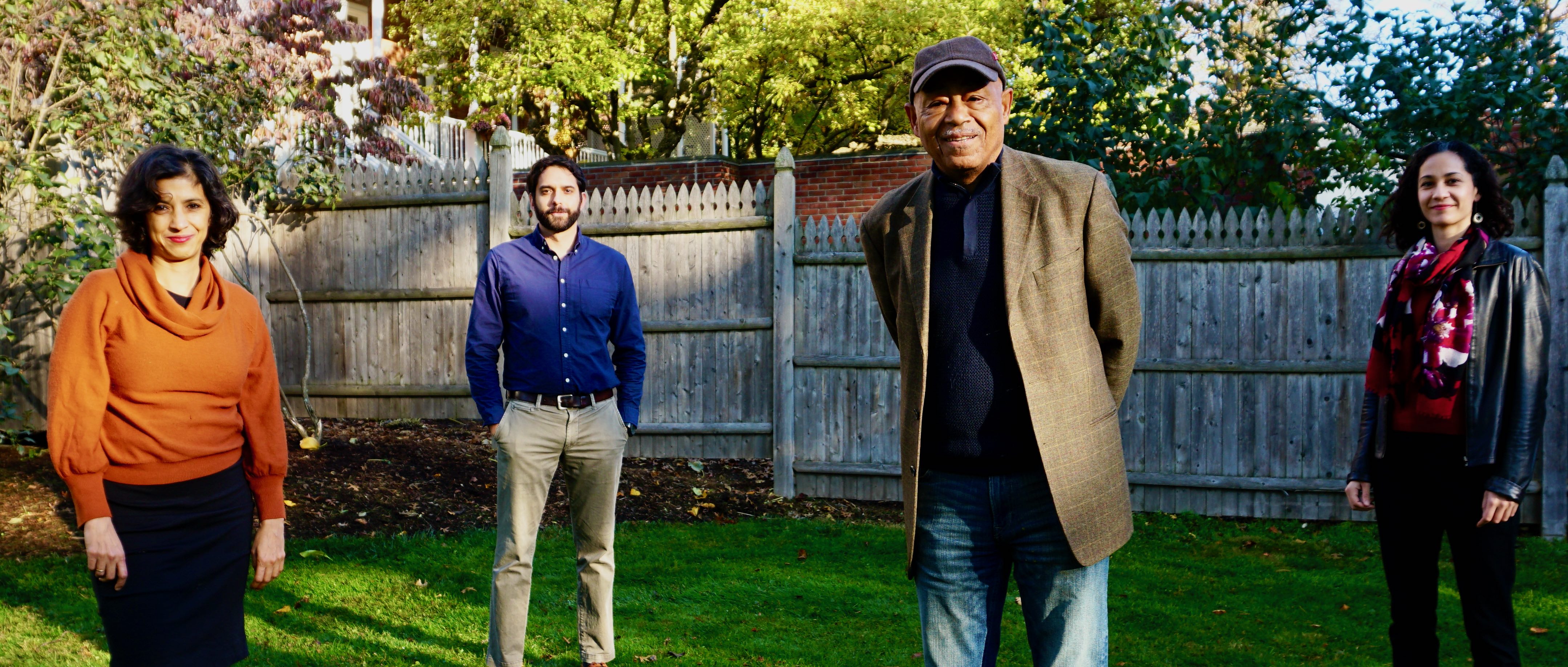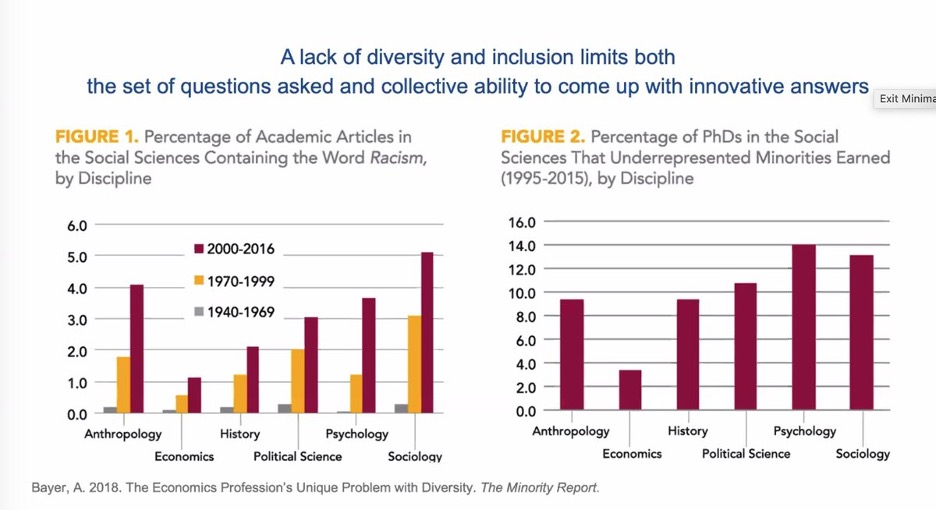Looking back on the Race, Ethnicity, Gender, and Economic Justice Virtual Symposium
Visiting scholars Ceren Baysan and Yusuf Neggers describe the series of events they co-organized with Rohini Pande and Gerald Jaynes October 28–November 5, 2021. The Symposium was co-hosted by EGC and Inclusion Economics.

In her influential 2020 book Caste, Isabel Wilkerson relates the social stratification system in India with equivalent hierarchies in other contexts, from the current-day United States to Nazi Germany. She writes:
"As we go about our daily lives, caste is the wordless usher in a darkened theater, flashlight cast down in the aisles, guiding us to our assigned seats for a performance. The hierarchy of caste is not about feelings or morality. It is about power – which groups have it and which do not."
The discipline of economics has developed tools that may be used to light up the dark theater in Wilkerson’s metaphor – analytical methods to identify which groups have power and which do not, and perhaps formulate policies that begin to address the imbalances.
A recent series of events that we helped organize made steps toward filling gaps in our understanding of the links between social identity and inequality. Conceived by two Yale economics professors – Gerald Jaynes, the A. Whitney Griswold Professor of Economics, African American Studies, and Urban Studies and Rohini Pande, the Henry J. Heinz II Professor of Economics and Director of EGC – the Race, Ethnicity, Gender, and Economic Justice Virtual Symposium presented new research by economists and political scientists from around the world. The program was hosted by EGC as part of its 60th Anniversary celebration, and by the new research initiative Inclusion Economics based at EGC and the MacMillan Center.

The program began on October 28, 2021 with a virtual panel discussion “The Decolonization of Development Economics” which focused on early contributions of economists from the Global South. You can watch the program here. Then followed two days of virtual conference sessions where economists and political scientists presented papers on race, ethnicity, gender, and economic justice worldwide. Below, we briefly describe the sessions and link to this vital new research.
The Public Sector and Resource Allocation, October 29
In what ways do the effects of historically discriminatory government policies linger today, and what scope exists to reduce their remaining harms? And does underrepresentation of minority groups in the ranks of government officials necessarily undermine the real-world fairness of ostensibly impartial institutions?
The October 29th session began with studies considering the long-run impacts of racially and ethnically influenced government housing and educational policies, as well as the potential for gains to be achieved by shifting to more equitable practices.
The first study of the morning session asked how redlining – US government policies beginning in the 1930s that led to restricted access to credit for entire neighborhoods – affected the children who grew up in these areas. The authors find reductions in educational attainment, later-life income, and intergenerational mobility, as well as a greater likelihood of disability as an adult.
- “The Long-Run Effects of the 1930s Holc `Redlining’ Maps on Children”
- Authors: Daniel Aaronson, Shari Eli, Daniel Hartley, Adriana Lleras-Muney Bhash Mazumder, and Martha Stinson
- Speaker: Bhash Mazumder
In the next study, the authors analyzed the relationship between local government boundary lines and residential segregation in the US between 1990-2020. They find that local government boundaries explain an important share of racial stratification patterns in metropolitan areas, which hasn't changed over the last thirty years.
- “Dividing Lines: Racial Segregation across Local Government Boundaries”
- Authors: Tomas Monarrez and David Schönholzer
- Speaker: Tomas Monarrez

The final paper of the morning session considered the effects of the elimination of de jure segregation of Mexican-American school children in the United States following the 1947 Mendez v. Westminster court decision. Focusing on California, the authors find a significant increase in long-run educational attainment for Hispanics, with larger effects for those who began school after desegregation occurred.
- “The Long-Run Impacts of Mexican American School Desegregation”
- Authors: Francisca Antman and Kalena Cortes
- Speaker: Francisca Antman
The afternoon session featured research examining how citizens’ experiences with the government – and their ultimate well-being – may be influenced by how well their identities align with those of public-facing officials who possess discretionary decision-making power. Finally, the session concluded with a discussion of the implications of formally incorporating racial identity as a social construct, rather than implicitly as a biological fact, for empirical research on discrimination.
The opening study of the afternoon session analyzed racial differences in longevity using records from cohorts of Union Army veterans of the US Civil War. The authors first provide evidence of discrimination against Black veterans by the doctors who certified the disability necessary for the receipt of a pension. They then use this variation in the likelihood of pension provision by race to show that resulting differences in income led to large differences in mortality.
- “The Enduring Effects of Racial Discrimination on Income and Health: Evidence from American Civil War Veterans”
- Authors: Shari Eli, Trevon Logan and Boriana Miloucheva
- Speaker: Shari Eli
The authors of the second paper examined the potential existence of judicial in-group bias in Indian criminal courts. Using quasi-random assignment of cases to judges, they find that defendant outcomes are not impacted by a religious or gender match with the judge. Evidence of limited in-group bias is found in some contexts where identity is particularly salient.
- “In-group Bias in the Indian Judiciary: Evidence from 5 Million Criminal Cases”
- Authors: Elliot Ash, Sam Asher, Aditi Bhowmick, Sandeep Bhupatiraju, Daniel Chen, Tanaya Devi, Christoph Goessman, Paul Novosad, and Bilal Siddiqi
- Speaker: Paul Novosad
The concluding study of the session considered the implications of constructivist notions of race for quantitative research on discrimination. The author provides a theoretical framework for thinking about the impact of race as a socially constructed category and derives takeaways for future empirical work.
- “A Constructivist Perspective on Quantitative Discrimination Research”
- Author & speaker: Evan Rose
Inequality and Income Support, November 5
Research featured on the second day of conference sessions explored how social stratification affects policy response and policy design.
The studies in the morning session considered who policies target and who benefits from them. How does occupational segregation interact with the impact of a minimum wage policy on racial earnings inequality? How does current support for income-based redistributive policies as demographics in society change depend on historical race relations?

The first study analyzed one of the most significant federal policies in reducing the historical and persistent racial earnings gap in the U.S. The authors find that the 1967 extension of the minimum wage to sectors where black workers are overrepresented can explain more than 20% of the reduction in the racial earnings and income gap during the civil rights era.
- “Minimum Wages and Racial Inequality”
- Authors: Ellora Derenoncourt and Claire Montialoux
- Speaker: Ellora Derenoncourt
The second study in the morning compared support for the welfare state between the U.S. and Europe. In the US, racial conflict hindered the creation of a universal welfare state. In Europe, racial diversity became salient after the creation of a universal welfare state. The paper explores the implications of these foundations for support for redistribution as the demographics of society.
- “Immigration and Support for Redistribution”
- Authors: Charlotte Cavaillé and Karine Van Der Straeten
- Speaker: Charlotte Cavaillé
Affirmative Action and Resource Allocation
The studies in the afternoon session investigated how to design optimal policies in respect to affirmative action in labor markets and political inclusion when systemic oppression occurs on multiple dimensions.
The first study discussed the design of affirmative action policies. The authors challenge the popular discourse that merit-based allocations are optimized with color-blind selection and awarding those with the highest test scores.
- “Meritocracy in the Face of Group Inequality”
- Authors: Rajiv Sethi and Rohini Somanathan
- Speaker: Rajiv Sethi
The second paper challenged the common approach of setting quotas to solve one dimension of political exclusion (e.g., based on gender or caste). The authors find one-dimensional quotas magnify social barriers to interactions and increase inter-group conflict. In comparison, two-dimensional quotas consistently improve relations and diminish conflict.
- “Are Quotas in Two Dimensions Better than One? Intersectional Representation and Group Relations and India”
- Authors: Rachel Brulé and Aliz Toth
- Speaker: Rachel Brulé
Filling gaps in both knowledge and representation
Even as economics has turned its attention to inequality in recent years, it been slow to study racism and other biases that that underlie it. The Figures below, from a report by Amanda Bayer for the Diversifying Economic Quality project, show that in economics, compared to other disciplines, issues such as racism are understudied, and minorities are underrepresented in the ranks of PhDs.

We see this symposium as a step toward filling these gaps – both in terms of the topics covered, and the diversity of the researchers who presented their work.
We thank Professors Jaynes and Pande for the chance to participate, and also the discussants who gave valuable feedback on the papers and fielded audience questions during the Q&A: Marcus Casey, Sun Kyoung Lee, Tomás Monarrez, Rebecca (Linchi) Hsu, William Bunting, Andria Smythe, and Charity Troyer Moore.
Ceren Baysan is Assistant Professor of Economics at the University of Essex and a Visiting Assistant Professor in International Development at Yale University with EGC and Jackson Institute for Global Affairs. Yusuf Neggers is an Assistant Professor at the Ford School of Public Policy at the University of Michigan, and a Visiting Research Scholar at EGC and the Yale MacMillan Center.